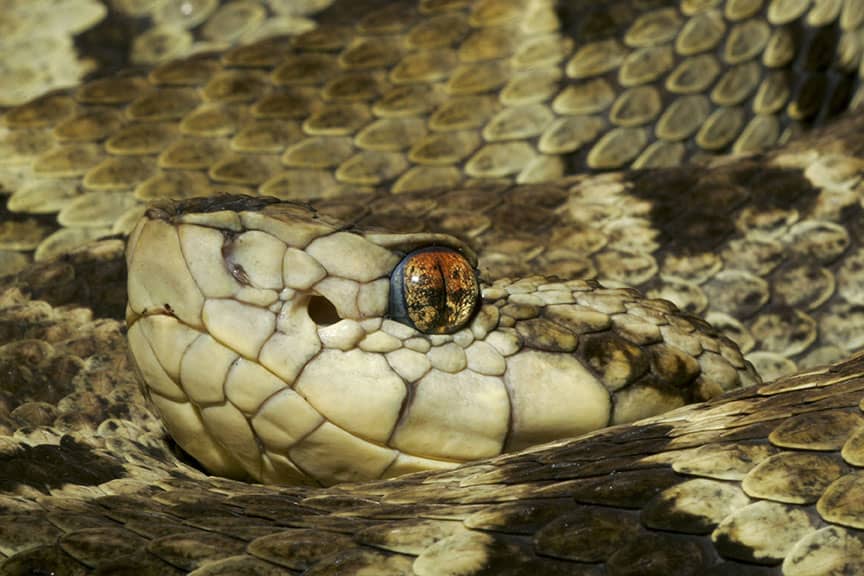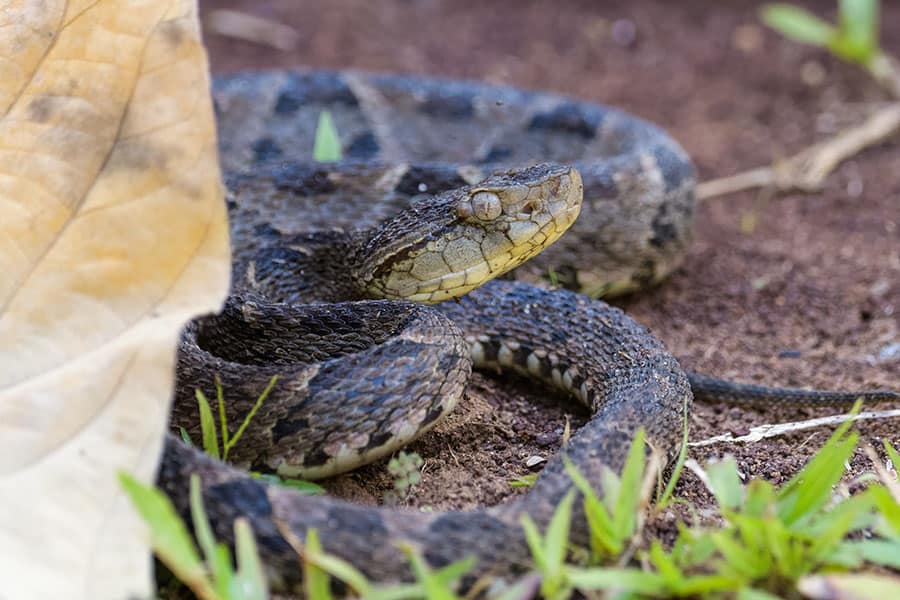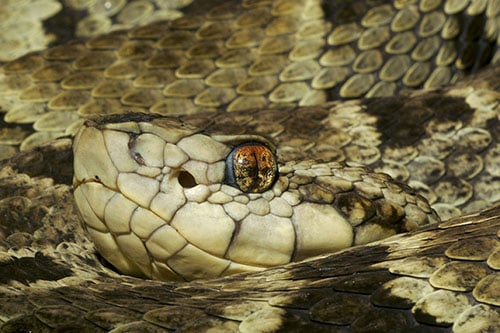
Picture this: I’m trekking through Carara National Park, camera in hand, chasing shots of vibrant birds and curious monkeys, when my friend suddenly freezes. “Don’t move,” he whispers, pointing to a coiled, camouflaged creature just feet away. It was my first encounter with a Fer-de-Lance, and I had no clue how dangerous it was.
Luckily, my friend did, and we backed away slowly, hearts racing. That moment sparked my fascination with Costa Rica’s most notorious snake, the Fer-de-Lance (Bothrops asper), known locally as the terciopelo or barba amarilla. If you’re planning a trip to Costa Rica, here’s everything you need to know about this venomous viper, from its deadly bite to its role in the rainforest ecosystem.
What Is the Fer-de-Lance?
The Fer-de-Lance, scientifically named Bothrops asper, is a pit viper renowned for its potent venom and striking appearance. Found from southern Mexico to northern South America, this snake is a heavyweight in the viper family, often called the “ultimate pit viper” for its size, fangs, and defensive nature. In Costa Rica, it’s the most dangerous snake, responsible for nearly half of all snakebites in the country.
Despite its fearsome reputation, it prefers to avoid humans, striking only when cornered or threatened. Its name, meaning “spearhead” in French, reflects its distinctive V-shaped head, a hallmark of its lethal precision.
Where Can You Find the Fer-de-Lance in Costa Rica?
The Fer-de-Lance thrives in Costa Rica’s lush, moist environments, particularly at low to middle elevations up to 2,000 feet (600 meters). You’ll find it in tropical rainforests, premontane forests, and even drier deciduous forests near rivers or streams. It’s no stranger to human-altered landscapes either, often lurking in banana plantations or near rural areas where rodents are plentiful.
National parks like Palo Verde, Chirripó, Corcovado, Tortuguero, and Carara are prime spots to encounter this snake, though its excellent camouflage makes it hard to spot. If you’re hiking in these areas, stick to trails and watch your step—locals call it the “Costa Rican landmine” for a reason!
What Does the Fer-de-Lance Look Like?
The Fer-de-Lance is a master of disguise, with a color palette that blends seamlessly into its surroundings. Its body, typically 4 to 6 feet long (1.2 to 1.8 meters), can be gray, brown, olive, or green, adorned with dark diamond patterns outlined by light stripes. Females are larger, sometimes reaching up to 8.2 feet (2.5 meters) and weighing as much as 13 pounds (6 kilograms).
The snake’s broad, lance-shaped head is darker on top and creamish-yellow underneath, with large eyes and vertical pupils. Juveniles sport brighter colors and yellow or beige tail tips, which they wiggle to lure prey—a behavior called caudal luring.
How Dangerous Is the Fer-de-Lance?
Let’s not sugarcoat it: the Fer-de-Lance is deadly. Its long fangs deliver a hemotoxic venom that coagulates blood, destroys tissues, and causes severe swelling and internal bleeding. On average, a single bite injects 105 mg of venom, while just 50 mg can be fatal to humans. In Costa Rica, it accounts for 46% of snakebites and 30% of hospitalizations, particularly among plantation workers.
However, fatalities are rare thanks to effective antivenoms developed locally at the Instituto Clodomiro Picado. The snake’s aggression is often overstated—it’s defensive, not malicious, and bites usually occur when it feels threatened. Still, its quick strikes and unpredictable nature make it a snake to respect.
Diet and Hunting: What Does the Fer-de-Lance Eat?
The Fer-de-Lance is a carnivorous ambush predator with a diverse menu. Adults feast on small mammals like rodents, opossums, and bats, as well as birds, amphibians, and other reptiles. Juveniles stick to smaller prey, such as lizards, frogs, and invertebrates like centipedes or beetles.
Using heat-sensing pit organs between their eyes and nostrils, they detect warm-blooded prey with pinpoint accuracy, even in the dark. Once they strike, their venom immobilizes the victim quickly, allowing the snake to track and consume it. This predatory prowess helps control pest populations, making the Fer-de-Lance an unsung hero in Costa Rica’s ecosystems.
Reproduction and Life Cycle
Unlike snakes that lay eggs, the Fer-de-Lance is viviparous, giving birth to live young after a gestation period of six to eight months. Females produce litters of 10 to 80 babies, depending on their size, with larger mothers birthing more offspring.
hese neonates, about 12 inches long, are born venomous and independent, sporting brighter colors than adults. They reach sexual maturity at around 3 to 4 feet—females slightly later than males. In the wild, their lifespan varies due to predation and environmental factors, but in captivity, they can live over 20 years. Their reproductive cycle in Costa Rica often aligns with rainy seasons, when prey is abundant.
Behavior and Temperament
Primarily nocturnal, the Fer-de-Lance spends its days coiled in leaf litter or under forest cover, emerging at dusk to hunt. Juveniles are semi-arboreal, climbing low vegetation, but adults are mostly terrestrial. Solitary by nature, these snakes are quick to flee from danger but can turn defensive in a flash, adopting an S-shaped coil and vibrating their tails as a warning.
While some individuals are surprisingly calm, others are excitable, earning the species a reputation for unpredictability. Their ability to blend into their surroundings makes them a hidden hazard for unwary hikers.
Predators and Threats

Despite its venom, the Fer-de-Lance isn’t invincible. It falls prey to other snakes, like coral snakes and blacktail indigos, as well as birds of prey such as falcons, hawks, and eagles. Mammals like didelphine opossums, which have some venom resistance, may also pose a threat, though the snake’s potent venom can overpower even these predators if they’re not fully grown. Human activity, including deforestation and agricultural expansion, impacts their habitat, but their adaptability keeps their populations stable.
Conservation Status and Local Importance
The Fer-de-Lance is classified as “Least Concern” on the IUCN Red List, thanks to its wide range and ability to thrive in varied environments. In Costa Rica, it plays a vital ecological role by controlling rodent populations, benefiting farmers despite its danger to humans.
Its venom is also a subject of medical research, with potential applications in pharmaceuticals. However, habitat loss and retaliatory killings pose localized threats. Conservation efforts focus on educating communities about snake safety and promoting antivenom access to reduce conflicts.
Recent Studies and Insights
Recent research highlights the Fer-de-Lance’s evolutionary arms race with prey like opossums, suggesting its venom’s potency developed to counter resistant predators. Studies, such as those by Wasko and Sasa (2009), explore its spatial ecology, revealing activity patterns tied to prey availability. Others, like Vega-Coto et al. (2015), document arboreal behaviors in juveniles, shedding light on their adaptability. These findings underscore the snake’s complex role in Costa Rica’s ecosystems and inform conservation strategies.
Staying Safe Around the Fer-de-Lance in Costa Rica
For travelers, encountering a Fer-de-Lance is rare but possible, especially in national parks. To stay safe, wear sturdy boots, stick to marked trails, and avoid reaching into unseen areas like under rocks or logs. If you spot one, give it plenty of space—never attempt to handle or provoke it.
In case of a bite, seek medical attention immediately; Costa Rica’s hospitals are well-equipped with antivenom. Guided tours with knowledgeable locals can enhance safety while offering a chance to learn about this fascinating predator in its natural habitat.
Quick Facts Table
| Attribute | Details |
|---|---|
| Scientific Name | Bothrops asper |
| Spanish Names | Terciopelo, barba amarilla (“yellow chin”) |
| Size | 4–6 ft (1.2–1.8 m), up to 8.2 ft (2.5 m) for females |
| Weight | Up to 13 lb (6 kg) |
| Habitat | Tropical rainforests, premontane forests, plantations, near rivers |
| Diet | Small mammals, birds, amphibians, reptiles, invertebrates (juveniles) |
| Venom | Hemotoxic, fatal dose ~50 mg, average bite ~105 mg |
| Reproduction | Viviparous, 10–80 live young, gestation 6–8 months |
| Lifespan | Up to 20+ years in captivity, variable in wild |
| Conservation Status | Least Concern (IUCN Red List) |
| National Parks | Palo Verde, Chirripó, Corcovado, Tortuguero, Carara |
Explore Costa Rica’s Wild Side
The Fer-de-Lance is a captivating, if daunting, part of Costa Rica’s rich biodiversity. Whether you’re hiking through Corcovado’s dense jungles or exploring Carara’s trails, understanding this snake adds depth to your adventure. Respect its space, stay vigilant, and you’ll leave with stories of Costa Rica’s wild beauty—maybe even a glimpse of the “Costa Rican landmine” itself.

